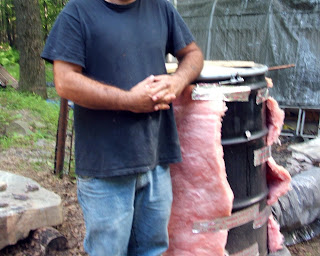It's September, and the beefsteak tomatoes are still green. I don't mean that some of them are green, or that the 2nd set is green, I mean they are ALL GREEN. I'm getting ahead of myself. Let's begin at the beginning.
Back in late May we planted 5 tomato plants. 3 were called "Sweet Baby" cherry tomatoes. The other two were "Mountain Harvest" and "Beefsteak" respectively. We didn't want to overdo it with too many plants. Last year, after all, was a horrific failure. What few tomatoes did emerge were quickly taken over by a blight, and we did not get to eat a single one. So naturally, we did not expect too much this year. We were wrong.
In early June we found a tomato plant, growing strong back where the pig pen used to be. This volunteer plant looked so nice and healthy that we decided to plant it in the last spot with the big tomatoes. After all, the bush beans had failed miserably in that spot, so what did we have to lose? The space was probably wasted one way or the other.
The early signs were not great. The tomato plants were tall and spindly with few leaves. So, as soon as the first flowers appeared, Mr. Farmer cut all the tops off just above the flowers. I really thought they were going to die. Instead they stalled- then bushed out! Two rows of flowers turned into four and eight and more! Before we knew it, we were up to our eyeballs in cherry tomatoes- at least we would have been if the tomato plants weren't right next to the front door where all who entered or exited could see them and be tempted by their beautiful bright red color.
Soon after the first cherry tomatoes reddened, the first large tomatoes bloomed. Little tomatoes became big tomatoes and... that's it. They just stopped growing. Hard, full size tomatoes sat on the vine and did nothing as weeks became months. A handful of cherry tomatoes were enjoyed each day along with the thought, "Maybe tomorrow the big ones will turn red." Neighbors and co-workers gave gifts of big, overripe tomato excess from their gardens, and yet ours stayed green.
On the 13th of September, the hail came. A slight blush had finally graced ONE of the large tomatoes and hopes were high. But in the early evening, a furious storm came through, pounding with pea-sized hail and equally large raindrops. The garden looked like it had seen the first fall snow. The only difference was that the white ice was only on the ground, not on the leaves of the plants. We figured our tomatoes were done for.
Much of the foliage on the tomato plants died off, but the large tomatoes remained, and the cherry tomatoes continued to redden. The herb garden wasn't so lucky:
 |
| My Poor Parsley- Beaten Flat and Frozen- Perhaps Dead |
 |
Our Beautiful Basil- Now Perforated from the Hail
|
 |
| Even My Seemingly Indestructible Chives Succumbed |
We removed as much of the hail as possible as quickly as possible, and the work paid off. But the large tomatoes are still green. They are dented, but they are still rock hard and dark green. I wonder if we will be able to eat any of them before the first frost hits???
*****LATE SEPTEMBER UPDATE!!*****
They're red! Finally! As of September 27, we have SIX red tomatoes, and several more are beginning to blush. We might be able to eat them all before the leaves are off the trees and the first snow falls after all!


































